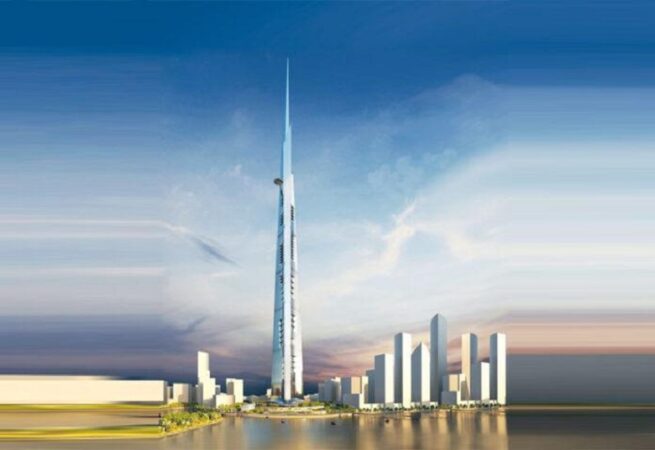In a house located on the 320th floor, at a kilometer altitude, what is life like?
There is no one in the world currently in these conditions: Dubai's Burj Khalifa, the tallest building in the world since 2014, is 828 meters high but is only inhabited at 584 metres, on the 163rd floor. What follows are floors occupied by machines and an antenna extending Somewhat hyperbolic.
However, there are two projects in Saudi Arabia that will raise the bar: the Jeddah Tower, which was planned in 2011 to reach a height of 1.6 kilometers (the symbolic mile of the famous utopian skyscraper designed by Frank Lloyd Wright in the 1990s). But it “shrank” to a thousand meters under the supervision of geologists who analyzed the terrain. Work began in 2014 and was suspended at a height of 390 meters in 2017, when the project's promoter, Prince Bin Talal, fell out of favor with the Saudi government and ran out of credit – however, construction has gained new momentum in 2023.
But in this “competition” for the heights, the most extravagant news has arrived from Riyadh: the Public Investment Fund, which invests oil profits and is headed by Prince Mohammed bin Salman, has hired Norman Foster studio to design a 2-kilometre-tall tower to be built in the north of Riyadh: the project's budget is 4.62 billion. euro.
In Burj Khalifa, there are entire floors of offices and apartments that were not previously inhabited, according to the Spanish newspaper El Mundo, but this does not seem to be a relevant fact. Viewpoints and restaurants for tourists do their job and generate money, while the name of the building is known all over the world. Not on the level of the Eiffel Tower, but more than any other building in the 21st century.
But what is the need for this race? “My hunch is, first and foremost, that there is social status in living physically and metaphorically above others. Second, lifestyles that promise a form of luxury and an escape from the crowding, pollution and crime that are often associated with the streets. And third, the sense of seeing the world from above.” explained Andrew Harris, Professor of Urban Studies and Geography at University College London.
“It's a strange situation: many wealthy people today seem to want to live uptown, even if it requires a lot of extra expenses. But we shouldn't treat this desire as something radically new. New heights and shapes are certainly “It's a feature of 21st century skyscrapers, but there are important precedents. Until the beginning of the 20th century, the best place to live was on the ground, not the top. Then everything changed because of technology.”
But the two-kilometre-high tower has led to geopolitical analysis: facing a future in which hydrocarbons are no longer an endless wealth for Saudi Arabia and its neighbours, the idea of its elites is to turn their cities into enclaves of free life for the world. Billionaires on this planet.
What remains to be considered is what life might be like in a building with these characteristics. What do you do with a building two kilometers high? Eduardo Prieto explained: “It is expected that the first third of the building will be allocated to offices and commercial uses, the second third to residences and hotels, and that the third will not have many other uses besides views and some technical services.” Architect and professor at the Polytechnic University of Madrid.
The building's ground floors, which have very deep bays and no interior courtyards, can only be used to house offices or shopping malls. As the building rises and becomes narrower, offices disappear and houses appear, because in Saudi Arabia there is not and will not be a demand for such a large number of office space. In fact, all over the world, office towers are already being emptied, recycled and converted into residential buildings. In recent years, major technology companies have preferred to set up their headquarters in horizontal, discreet buildings.
Burj Khalifa has 900 apartments between the 19th and 77th floors, described in some reports as “well designed in detail, but a bit cavernous.” But the project in Riyadh defies logic: just for vertical movements, leaving the house, going down the street and returning home, it can take, even with the fastest elevators, 30 minutes, with multiple transfers. This is the time that creates the “necessity”: anyone who lives in a two-kilometre-tall tower wants to live outside the world.
For example, on the 320th floor, the windows cannot be opened, to avoid pressure changes that break the constant pressure that has to be boosted, as in airplanes. “The alienation from the world would be complete. I'm not even sure the views are worth it. At 200 meters above sea level you can see the city, but a kilometer and a half away you can only see fog and clouds, and you can't see people,” said Eduardo Prieto. in the street”.

“Hardcore alcohol maven. Hipster-friendly analyst. Introvert. Devoted social media advocate.”
